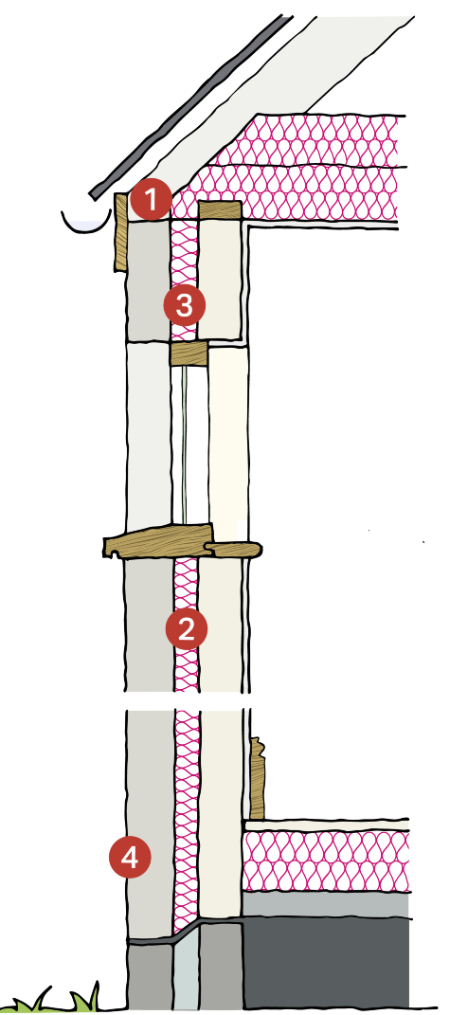
1. The edges of cavities at the roof and openings may need physical closers installed to ensure the insulation does not escape.
2. Typically, fibre insulation or expanded polystyrene spheres are injected into the cavity through a series of entry holes drilled in the facade. The cavity is fully filled.
3. Some additional insulation measures may be needed around lintols, vents, and other features which bridge the cavity.
4. Cavity wall insulation should be carried over the abutment with other insulation measures at the head and foot of the wall, to ensure there are no cold spots on the exterior at the floor and roof.
The majority of buildings constructed in the 20th century have external walls constructed of two layers, the outer being a weathering skin and the inner one usually structural. Space between the layers is a cavity used to drain any moisture which passes though the outer layer preventing it from reaching the inside.
These cavity walls are usually quite thin and, being made of slender components, normally have low thermal performance.
Cavity wall insulation is a method of improving the building envelope by insulating the void between the skins of a cavity wall.
A number of methods are available which involve an insulant being injected into the void. These insulants vary in their thermal efficiency, moisture resistance, and integrity (ability to support themselves). The more commonly used insulation types are expanded polystyrene spheres and blown fibres.
The insulation is normally fitted over 1 to 2 days with holes drilled at intervals on the facade to allow the insulation to be injected. Particular care must be taken at openings, perimeter of the cavities, ventilation routes, and damp-courses to ensure the building can function as designed. A detailed survey will need to be undertaken by the installer to assess the suitability of the building for the insulation type being proposed.
Some highly exposed walls may not be suitable for cavity wall insulation.
In later modern homes the cavity may already be partially filled with an insulation board, and here retrofitting top-up insulation can be difficult as the void can be quite narrow.
This insulation can be fitted without disruption, making it a suitable choice for many.
The external walls of any building are normally the largest proportion of its envelope and so offer the greatest potential for heat loss. This element is therefore very important to improve.
The effectiveness of the insulation will vary with the type of insulation chosen, size of cavity, and proportion of wall to say windows, roof, etc.
For most, an improvement in wall performance of around 35% will be possible.
You should use recycled materials wherever possible.
This cost will vary with the type of insulation, thickness of cavity and complexity of building – e.g. amount of scaffold required. Typical payback periods for cavity wall insulation are medium term, between 5-8 years. According to data from BEIS, the estimated cost of cavity wall insulation is between £22 and £26 per m2.
Some grants and financial assistance are available. Refer to the Energy Savings Trust, your utility company, or our Energy at Home website for more information.
Listed Building Consent is required for cavity wall insulation within heritage assets.
Pre-1920 houses are more likely to have solid walls. A solid wall has no cavity. Each wall is a single solid wall, usually made of brick or stone. It is unlikely that cavity wall insulation is a relevant retrofitting measure for consideration in most heritage assets or buildings of a traditional construction. Where this is not the case, please refer to the further guidance below from Historic England on Insulating Early Cavity Walls or contact us for more information.
We support the use of cavity wall insulation where appropriate.
In the light of the Climate Emergency, we will generally permit and encourage alterations on listed buildings, with special regard to the the following:
- Preserving the building, its setting or any features of special architectural or historic interest which it possesses
- Preserving or enhancing the character of a conservation area
- Respecting the significance of any non-designated heritage asset
Insulating Cavity Walls from Historic Engalnd
Cavity Wall Insulation from Centre for Sustainable Energy
